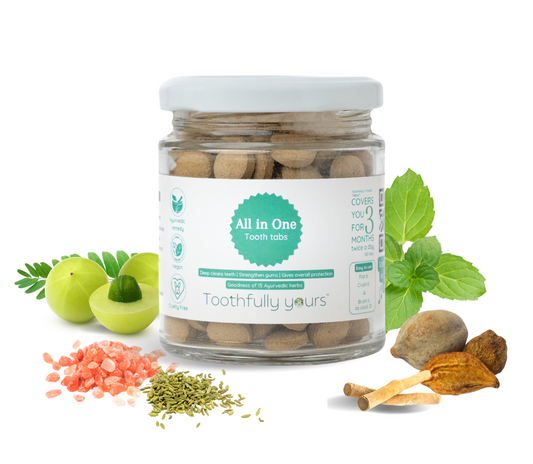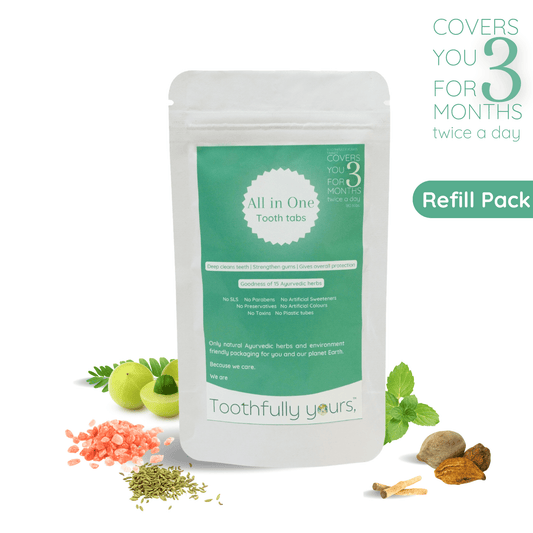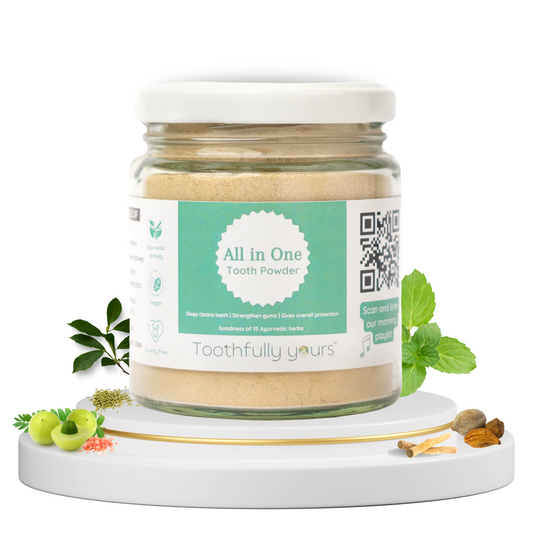
What is Oil Pulling? All You Need to Know
Oil pulling is a traditional Ayurvedic practice of swishing the oil or keeping the oil in the mouth until eyes or nose become watery to promote a variety of health benefits. But what is oil pulling exactly, and how does it work? In this blog, we'll delve into all the details you need to know to understand and practice oil pulling in your daily life.
What is Oil Pulling?
Oil pulling is a natural and holistic Ayurvedic practice that is practices in two ways:
1. Kavala - In Kavala, a small amount of oil is placed in the mouth and swished around for a period of 15-20 minutes, gargled until oil becomes watery and removed.
2. Gandusha - In Gandushaa, the entire mouth is filled with oil (more so than with Kavala) and held still till eyes or nose becomes watery. Then swished around for a period of three to five minutes before being eliminated.
Using oil in your mouth for a period of time, typically 15 to 20 minutes, helps cleanse the mouth and promote oral and overall health. This ancient method draws out toxins, improves dental hygiene, and supports a healthy, balanced lifestyle. It has been practiced in Ayurveda for centuries as a way to maintain oral health and detoxify the body.
How Does Oil Pulling Work?
The process of oil pulling involves using oils, typically coconut, sesame, or sunflower oil, which have antibacterial, antifungal, and antiviral properties. When swished around the mouth, the oil works as a mild cleanser, binding with bacteria, toxins, and debris, which are then removed when the oil is spit out. The oil's viscosity helps to "pull" out impurities from the mouth, making it an effective detoxifier. It also promotes saliva production, which can aid in further cleaning the teeth and gums.
Benefits of Oil Pulling
-
Improved Oral Hygiene: Regular oil pulling can help reduce plaque, prevent cavities, and maintain overall oral cleanliness.
-
Whiter Teeth: By removing surface stains and bacteria, oil pulling contributes to brighter, whiter teeth.
-
Gum Health: Oil pulling helps reduce gum inflammation, bleeding, and gingivitis.
-
Detoxification: This practice is believed to help detoxify the body by removing toxins from the mouth and bloodstream.
-
Improved Breath: Oil pulling can reduce bad breath (halitosis) by eliminating odor-causing bacteria in the mouth.
-
Overall Health Benefits: Some proponents believe oil pulling can help with headaches, improve skin health, and even aid in digestion and allergies.
How to Do Oil Pulling Step-by-Step
1. Choose Your Oil: Select a cold-pressed, organic oil. Common choices include coconut oil, sesame oil, and sunflower oil.
2. Take a Tablespoon of Oil: Start with about one tablespoon of oil. If you're new to oil pulling, begin with a smaller amount and gradually increase as you get comfortable.
3. Swish the Oil Around (Kavala method): To begin oil pulling, start with Kavala and later bring Gandusha as well in the routine. Gently swish the oil around your mouth for 15 to 20 minutes. Be sure to move the oil through all areas of the mouth, between teeth, and along the gums.
4. Spit It Out: After swishing, spit the oil into a trash can (not the sink, as it can clog pipes).
5. Rinse Your Mouth: Rinse your mouth thoroughly with warm water to remove any remaining oil residue.
6. Brush Your Teeth: Finish by brushing your teeth as usual to ensure your mouth feels clean and fresh.
Potential Side Effects and Precautions
-
Allergic Reactions: If you’re sensitive to certain oils, like sesame, discontinue use and choose a different oil.
- Oil Sensitivity: Avoid swallowing the oil as it contains bacteria and toxins drawn from your mouth.
Who Should Avoid Oil Pulling?
People with certain health conditions: If you have a medical condition, especially one related to oral health or the mouth, it’s best to consult your dentist before beginning oil pulling.
How to Dispose of Oil After Oil Pulling?
It’s important to dispose of the used oil properly. Never spit the oil down the sink, as it can clog your plumbing. Instead, spit it into a trash can or compost bin. You can also use a disposable paper towel to wipe out your mouth and dispose of it safely.
How to Get Started With Oil Pulling
To get started with oil pulling, it’s best to begin with a few minutes of oil swishing per day, gradually increasing the time to 15-20 minutes. You can incorporate it into your morning routine before eating or drinking anything. Remember, consistency is key, so practice it regularly for the best results.
Is it OK to Do Oil Pulling Every Day?
Yes! Oil pulling can be done daily, as part of your morning routine, to reap the full benefits. Many people choose to practice oil pulling once a day, although some prefer doing it multiple times a day for enhanced results. Be sure to listen to your body and adjust accordingly.
Which Oil is Best for Oil Pulling?
-
Coconut Oil: This oil is rich in lauric acid, known for its antibacterial and anti-inflammatory properties, making it a popular choice for oil pulling.
-
Sesame Oil: Sesame oil is the first oil recommended in traditional Ayurvedic practices, rich in copper, manganese, calcium, magnesium, iron, phosphorus, vitamins and zinc, which are crucial for maintaining bone density and strength. Sesame oil is also excellent in removal of tartar and reducing toxins from the oral cavity.
-
Sunflower Oil: Sunflower oil has a neutral taste and contains antioxidants, making it a mild option for oil pulling.
What is the Best Time to Do Oil Pulling?
The ideal time to do oil pulling is first thing in the morning, on an empty stomach, before you eat or drink anything. This allows the oil to effectively cleanse the mouth and remove any toxins accumulated overnight. Swishing oil before brushing your teeth ensures your mouth is fully cleaned and free of harmful bacteria.
FAQs on Oil Pulling
1. How often should I oil pull?
Daily oil pulling, particularly in the morning, is ideal for maximum benefits, although some people may opt for a few times a week.
2. Can I eat or drink right after oil pulling?
It’s best to wait about 15-20 minutes before eating or drinking, allowing the oil to work its full magic. Afterward, rinse your mouth thoroughly before consuming anything.
3. Does oil pulling really whiten teeth?
Yes! By removing plaque and surface stains, oil pulling can gradually help whiten teeth over time. However, it’s not a substitute for professional dental whitening.
4. Can I brush immediately after oil pulling?
Yes, after oil pulling, you can brush your teeth to remove any remaining residue and ensure your mouth feels fresh and clean.
Conclusion
Oil pulling is a simple, natural Ayurvedic practice that has stood the test of time. By incorporating it into your daily routine, you can experience a variety of oral health benefits while promoting overall wellness. Whether you're looking to improve your gum health, whiten your teeth, or simply detoxify your body, oil pulling offers a holistic and herbal way of caring for your mouth and body. Always remember to use organic, high-quality oils and be consistent with your practice for the best results!





